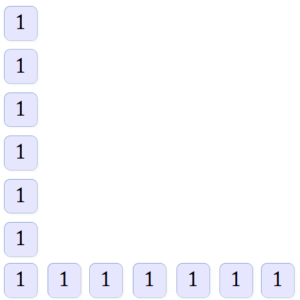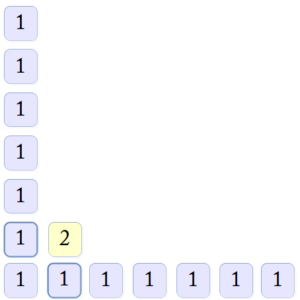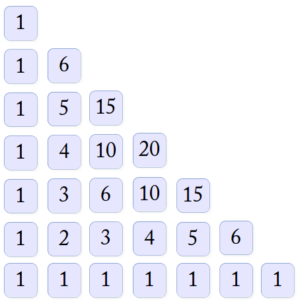The fifth combinatorial technique that Hēmacandra describes is called saṅkhyā, which simply means “number”: it gives the number of possible combinations of light and heavy syllables for a verse of k positions. This is the simplest of all of the techniques. For samavr̥tta meters, which have an equivalent number of positions in each line, the solution is simply 2k. Hence, as we have already seen, for k = 4, the number of possible combinations is 24 = 16. For meters of the śakvarī class, with fourteen syllables per line, the number of possible combinations is 214 = 16,384.
In case you want to find the number of possibilities up to a certain value of k (e.g., k = 1, 2, 3, 4 … 14), you can multiply the highest value of k by 2 and subtract 2 from the product. Hence, the total number of possibilities for k = 1, 2, 3, 4 … 14 is 2(214) -2 = 32,766.
For ardhasamavr̥tta meters, we have to modify the procedure somewhat. There should be a greater number of such meters: in samavr̥tta meters, all of the lines must be identical, but in ardhasamavr̥tta meters, only the first and third, and second and fourth, lines are identical to each other. Hence we start by raising the number of possibilities to the power of 2. For k = 4, this gives us (24)2 = 256. But this number also includes patterns where all four lines are identical, i.e., the samavr̥tta forms. We subtract the total number of these samavr̥tta forms, which in this case is 24 = 16. There are thus 240 ardhasamavr̥tta forms for k = 4. Hence the general formula is (2k)2 – 2k.
For mātrā-based meters, we have to generalize the procedure a little. In sama- and ardhasamavr̥tta meters, there can only be 2 possibilities for any given position, namely, light or heavy. This is not the case in mātrā-based meters. We must therefore multiply the number of possibilities at each position (effectively: each group, or gaṇa, of mātrā). Ignoring for the moment the requirements of word-break, the gāthā has the following possibilities at each group:
| First line: |
1st gaṇa |
2nd gaṇa |
3rd gaṇa |
4th gaṇa |
5th gaṇa |
6th gaṇa |
7th gaṇa |
8th gaṇa |
Product |
| Possibilities: |
4 |
5 |
4 |
5 |
4 |
2 |
4 |
1 |
12,800 |
| Second line: |
1st gaṇa |
2nd gaṇa |
3rd gaṇa |
4th gaṇa |
5th gaṇa |
6th gaṇa |
7th gaṇa |
8th gaṇa |
Product |
| Possibilities: |
4 |
5 |
4 |
5 |
4 |
1 |
4 |
1 |
6,400 |
Hence the number of possibilities is 12,800 × 6,400 = 81,920,000.
Finally, one might be interested, in principle, in how many possible combinations of light and heavy syllables can be accommodated within a unit (gaṇa) that contains a specified number of mātrās. We know, for example, that four mātrās can be realized by the following five patterns: ऽऽ, ।।ऽ, ।ऽ।, ऽ।।, ।।।।. But Hēmacandra tells us that the number of possibilities is a Fibonacci number. (Hēmacandra wrote about 50 years before Fibonacci, and the principle was known to earlier authors who were concerned with Prakrit metrics.) Thus:
| Number of mātrās: |
1 |
2 |
3 |
4 |
5 |
6 |
7 |
8 |
| Number of possible syllabic realizations: |
0 + 1 = 1 |
1 + 1 = 2 |
2 + 1 = 3 |
2 + 3 = 5 |
3 + 5 = 8 |
5 + 8 = 13 |
8 + 13 = 21 |
13 + 21 = 34 |


